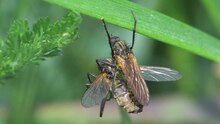Diced dance fly
| Diced dance fly | ||||||||||||
|---|---|---|---|---|---|---|---|---|---|---|---|---|

Diced dance fly ( Empis tessellata ) |
||||||||||||
| Systematics | ||||||||||||
|
||||||||||||
| Scientific name | ||||||||||||
| Empis tessellata | ||||||||||||
| Fabricius , 1794 |
The diced dance fly ( Empis tessellata ) is a fly from the family of dance flies (Empididae).
features
With a length of 9 to 13 millimeters, the diced dance fly is a relatively large species. Compared to most other dance fly species, it is also noticeable due to its strong physique. The basic color of the body is gray. The chest has three black vertical stripes on top. The segments of the abdomen are black on the upper side, usually with a gray to bronze colored coating (torment), and gray on the sides and below. The respiratory openings of the trachea are marked on each side by black dots. The head with the large, brown compound eyes is relatively small, the mouthparts are fused into a long proboscis. The legs are very variable in color, mostly at least the rails gray-brown, the hips and thighs always have a purely black color. The tarsi are usually brown at the base and black towards the tip. The wings are tinted brown, red-brown at the base. The swinging bulbs are conspicuously light to red-brown.
As with many dance flies, the sexes can be distinguished by the size of the eyes. In the male these are narrowly butting against each other, in the female they are broadly separated.
distribution
The diced dance fly is native to almost all of Europe, where it lives from the Mediterranean region to northern Scandinavia. Their distribution area extends in the south to North Africa (missing on the Canary Islands), in the east over the Middle East and Central Asia to Japan.
Way of life
The diced dance fly can be found on various plants at the edges of forests, in clearings and on damp meadows. It feeds on nectar and is often found on umbellifers when foraging . However, only the male also lives predatory and eats smaller insects, mostly two-winged animals. The prey can reach the size of the predator. A captured insect also plays a role in courtship. The male presents it to the female as a bridal gift before mating.
Adults can be expected in Central Europe in May and June, in the Mediterranean from March, in Scandinavia until August.
literature
- Milan Chvála: The Empidoidea (Diptera) of Fennoscandia and Denmark: Genus Empis. III Fauna Entomologica Scandinavica Vol. 29. Brill Academic Publishers, 1994. ISBN 9004096639 pp. 24-25
Web links
- Empis tessellata in Fauna Europaea

